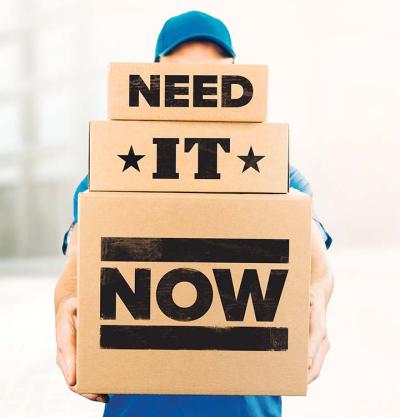Need It Now
Need It Now
 These days, you can buy products almost any way you want — in-store, via delivery or curbside pickup. That’s a result of a digital revolution in the past three decades, as the speed and convenience of business has completely shifted. But that also means there is much more that goes on behind the scenes to ensure consumers get products quickly and in the manner they choose. Companies use technology and space and leverage supply chains to make the magic happen.
These days, you can buy products almost any way you want — in-store, via delivery or curbside pickup. That’s a result of a digital revolution in the past three decades, as the speed and convenience of business has completely shifted. But that also means there is much more that goes on behind the scenes to ensure consumers get products quickly and in the manner they choose. Companies use technology and space and leverage supply chains to make the magic happen.
A key driver in the logistics shift has been omni-channel distribution, meaning there are multiple ways to get customers what they want and how they want it, said Andy Anderson, associate professor of management. Big-box retailers like Walmart or Target have to manage dozens of warehouses who ship to both stores and homes, depending on stock and consumer preference.
“This sounds pretty intuitive, but it’s actually really hard to do — manage your inventory for both scenarios,” Anderson said.
“Formerly, before everything was digital, there was one big centralized warehouse, and everything would ship out of one warehouse. But now, everyone wants their stuff faster. This means you have to have a larger number of smaller warehouses distributed throughout population centers.”
A report from Prologis, a logistics research company, predicts an additional 125 million square feet of warehousing space will be needed every year until 2025 in the United States and Europe just to keep up with current levels of e-commerce demand. This makes supply chains tough to manage — meaning the profession is in high demand — but it’s a necessary change to keep up with consumer expectations.
“Formerly, before everything was digital, there was one big centralized warehouse, and everything would ship out of one warehouse. But now everyone wants their stuff faster. This means you have to have a larger number of smaller warehouses distributed throughout population centers.”
“If you want customer responsiveness and a chance to compete in the digital age, then you have to be moving toward that model,” Anderson said. Omni-channel distribution has also affected how retailers look at storefront space. Aaron Hyde (Real Estate, ’06) works in commercial real estate in Des Moines and says many of his clients look at their brick-and-mortar locations as “showrooms” where consumers can pick out what they want to buy before online shopping.
“A lot of times, you’ll look at something online and you go to the story to try it on, feel it,” Hyde said. An example is Best Buy, which changed its business model to focus on providing an experience in their stores, where consumers can try out the technology before making a large purchase.
In most cases, this shift has led to smaller storefronts. Big-box chains like Target and department stores like Kohl’s and Macy’s have been shifting toward small-format stores in large cities, with reduced square footage and hyperlocal products. Even those with a lot of square footage are converting spaces to mini warehouses for ship-from-store models or bringing in other brands to bolster the consumer experience, Hyde said.
“You’re seeing less merchandise and more of an experience,” Hyde said. “Even leading up to [the pandemic], Target completely remodeled a lot of its stores. And you’re seeing a lot of the big guys bringing in other brands for micro shops within their stores."
Technology has also created more intelligent logistics tools. Bret Wiltse (Business Administration, ’00) has worked at Fareway Stores, an Iowa grocery chain, for his entire professional life. He’s now the senior vice president of direct store delivery, meaning he oversees all of the products shipped to stores, like milk, bread, chips, alcohol and more. He said there is an abundance of data to help him and his team make good decisions about what consumers want and when and how they want to buy it.
For example, if a product is more popular in the mornings, but a shipment time changes to the afternoon, Fareway’s tools will help Wiltse see there’s a need for more product to cover the next morning’s demand as well.
“The amount of data points we can get now with technology is just phenomenal,” Wiltse said. “Technology allows us to communicate a supply chain problem all the way from our manufacturers to our store managers to the people putting it on the shelf.”
Many grocers like Fareway have also moved to digital offerings, like online ordering or even delivery services. Fareway has an online shopping portal as well. Surprisingly, Wiltse says these new options only change supply chains in small ways, like trying to determine where inventory is when a customer wants to purchase it. Is the store out of stock at the moment that customer wants a product?
Wiltse says many of Fareway’s competitors have used automated systems to keep track of these issues, but Fareway relies on its team members, which helped them through the past year and a half.
“We feel like having the person who understands that section, making a great decision at that time, is the most beneficial and the most efficient way we can serve our customers,” Wiltse said. “It’s also the reason our stores did not see out of stocks like many of our competitors did during the pandemic. Because we weren’t in a position in which a machine had to learn; a person could notice that products were running out quickly and respond a little faster.”
Wiltse cautions that an overreliance on technology can be a problem. He said it’s important to verify numbers, whether that’s through experience or going the extra mile to double-check a shipment or product.
“One of the reasons that experience in the business is so vitally important,” he said. “The two big challenges are not verifying that data is correct and then not understanding when you don’t have all the data.”
Lauren Erwin (Supply Chain Management, ’16) has a big- picture perspective. She works for 3M, a Fortune 100 company with operations in 70 countries, as a supply chain planner. Erwin oversees several manufacturing plants in the Midwest, working with both the production and business teams to ensure the right products are prioritized and shipped.
Erwin has a passion for data analytics. Whenever she’s faced with a problem, she first turns to the numbers to solve a problem.
“I’m a huge believer in using data to make wise business decisions,” Erwin said.
“I always have data behind why I’m asking someone to do something. We have a plethora of information available that we never used to have.”
And Erwin doesn’t believe that will change. In fact, business intelligence will only grow smarter and stronger, helping businesses make more efficient decisions along the way. That only stands to help the customer, as they get services when and where they want.
The next generation of supply chain and retail professionals will get a leg up if they have some sort of data background, Erwin said.
“I would encourage anybody going into college to consider going into [data analytics],” Erwin said. “If anything, it’s just going to continue to expand. In my role as a supply chain analyst, we’re just going to lean on that data more and more to make decisions and learn how to best optimize all of our operations using facts and evidence.”




